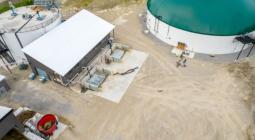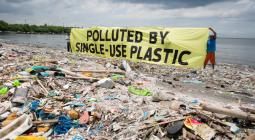Seventeen landfills in England make toxic liquid hazardous to drinking water
Exclusive: Investigation finds banned chemicals at levels up to 260 times higher than that deemed safe to consume
Seventeen landfills across England are known to be producing a highly toxic liquid substance containing some banned and potentially carcinogenic “forever chemicals”, in some cases at levels 260 times higher than that deemed safe for drinking water, it can be revealed.
However the government says it does not know where these landfills are.
Over a 10-month period from 2021 to 2022, consultants working for the Department for Environment, Food and Rural Affairs (Defra) and the Environment Agency were asked to take samples from a “number of different operational and closed landfills” developed between the 1960s and the present day in order to provide an “overall picture” of the chemical substances found in the landfills’ leachate.
The results of the sampling, published in an Ends Report investigation and shared with the Guardian, reveal that in one landfill, the total sum of per- and polyfluoroalkyl substances (PFAS) in the raw leachate sample was 105,910 nanograms a litre (ng/l).
PFAS are a group of about 10,000 human-made chemicals used in industrial processes, firefighting foams and consumer products. They are known as “forever chemicals” owing to their persistence in the environment.
In England there are no restrictions on the total sum of PFAS allowed in drinking water, but the Drinking Water Inspectorate’s guidelines allow levels of PFOS and PFOA – two of the most widely used and studied types of PFAS – in drinking water at up to 100 ng/l. In the US, the legal limit is 0.004ng/l for PFOA and 0.02 ng/l for PFOS.
In one sample PFOA was recorded at 26,900 ng/l – 260 times higher than the current guidance for safe levels in drinking water in England.
PFOA is considered to be toxic above certain levels and has been linked to a range of diseases in humans including kidney cancer, testicular cancer, hypertension, thyroid disease, ulcerative colitis, high cholesterol and reduced response to vaccines.
According to the Environment Agency’s own definition, landfill leachate is a “potentially polluting liquid” which “unless managed and eventually returned to the environment in a carefully and controlled manner, may cause harmful effects on the groundwater and surface water that surround a landfill site”.
Although the quantities of PFAS found in each sample varied – with the lowest total recorded being 79 ng/l – the average across all the samples was 19,497 ng/l.
The data provided to Ends revealing the high levels of PFAS in the landfill leachate did not include location information, meaning it is not possible to assess their potential to contaminate drinking water sources.
When queried, the Environment Agency and Defra said they did not know the locations of these landfills because the contractors provided the government with an anonymised dataset.
This, they said, was because the purpose of the study was to “build an initial nationwide (England) picture of substances in landfill leachate that are known to be or suspected to be harmful to the environment”. They said the “study was not intended to carry out monitoring for the purpose of compliance regulations”.
An Environment Agency spokesperson said none of the landfills assessed “found this leachate being discharged directly into the environment”. They added that the agency was “working closely with the landfill industry to deepen our understanding of chemicals and any challenges they pose”.
“This is a hugely important study that is now informing our longer-term approach to managing risks to the environment. Defra will be publishing a report in due course.
“The Environment Agency wants to provide government with really compelling advice, fully evidenced, on the scale of the PFAS challenge and how it may be dealt with. This study is a very useful first step but more work is essential.
“The research is not intended as regulatory monitoring – as such the names and site locations were not required for this particular work, which was carried out by a contractor on our behalf.”
However, the admission that the locations of the landfills are not known to Defra and the Environment Agency has shocked experts. Dr Shubhi Sharma, scientific research assistant at campaign group Chem Trust, said it was “extremely worrying” that the Environment Agency “claims not to know the locations of landfills where high levels of PFAS have been found in leachate”.
“How can action be taken by the Environment Agency and others to deal with the contamination of local groundwater and soil if they don’t know the source of it? Workers, local residents and businesses have a right to know if their workplace or local area is polluted with toxic chemicals,” she added.
Penelope Gane, the head of practice at campaign group Fish Legal, said: “You would have thought that someone in the Environment Agency would be sitting up and taking notice with PFAS readings coming back hundreds of times higher than safe limits for drinking. What exactly is stopping the agency going back to its contractors and asking for the location of these sites?”
While it is impossible to say where the 17 problem landfills are located, there are multiple pollution pathways associated with landfill leachate which are well known to environmental experts.
The Environment Agency has said that most of the sites targeted by the survey were operational landfills, receiving household and commercial waste which have containment systems to prevent leachate escaping into the ground or groundwater.
However, the Environment Agency says in its guidance that “even the best-engineered landfill sites will leak to some extent” and states that “while it is possible that the best of engineered landfill sites will contain and control leachate with minimal leakage, there is always a probability that some failure in engineering will occur”.
Landfills that are no longer operational have long been a concern owing to their potential for contamination. These landfills typically have no leachate or gas containment and limited or no records of the source, type, or volume of waste stored.
According to Kate Spencer, professor of environmental geochemistry at Queen Mary University and expert in historic coastal landfills, “if the landfills aren’t lined then they are almost certainly leaching those chemicals directly into the environment”.
Spencer said that when assessing the risk posed by these landfills it was important to think about the likelihood of people coming into contact with these concentrations. But to do that, you would need to know what the pathways are.
“If you were to tell me that one of these sites was a historic unlined site, and it was in close proximity to groundwater or to a river, and if you were to tell me that that groundwater or that river was also a drinking water source, then that’s concerning,” she said.
Cover photo: The government said the report was anonymised and it could not locate the landfills Photograph: Britstock Images Ltd/Alamy





